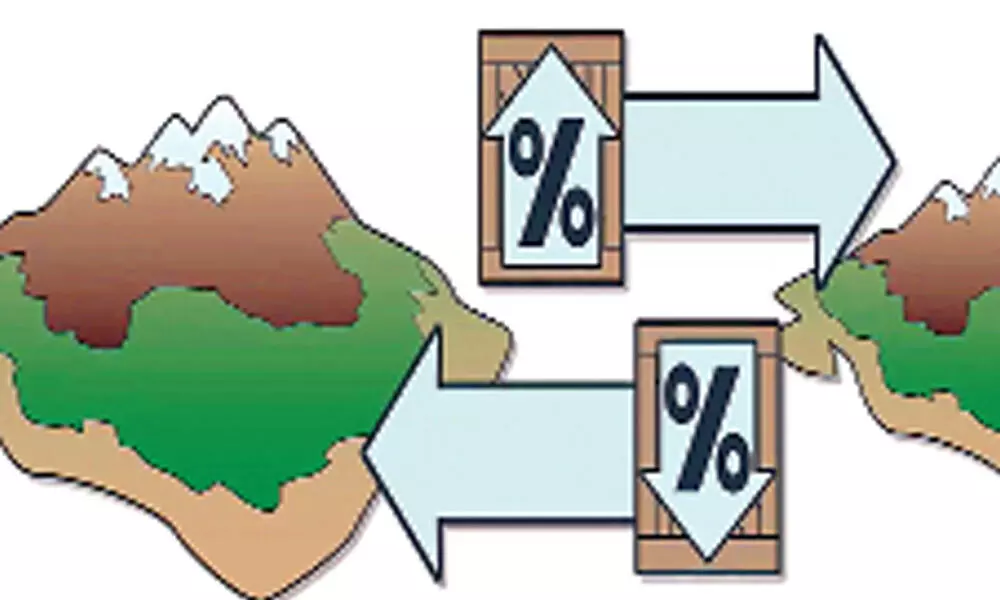Hidden dangers of trade surplus

Hidden dangers of trade surplus
Good news is that our exports were more than imports in the April-June of the current year 2020-21
Good news is that our exports were more than imports in the April-June of the current year 2020-21. The combined trade is known as "Trade Balance." Excess of exports over imports is known as "Trade Surplus." We have made such a trade surplus after 13 years. We are getting more dollars from exports and requiring less dollars for imports.
The Trade Balance is part of the "Current Account Balance." We get dollars from the exports made by us and from the investments made in India by foreign investors. On the other hand, we send dollars to pay for the imports made by us and from the outward investments made in other countries by our investors. The combined receipts from exports and inward foreign investments are called current account receipts. The combined remittances made for imports and outward foreign investments are called current account remittances. The net difference between current account receipts and remittances is known as "Current Account Balance."
As said above, our current account balance has turned positive in tandem with the trade surplus. We had incurred a Current Account Deficit of USD 15 billion in April-June 2019. "USD" stands for United States Dollars. This has now become a Current Account Surplus of USD 20 billion in 2020. This is good news. We are holding our fort in the global economy.
The second good news is that our exports of services have grown through marginally during the Covid pandemic. Our future lies in services and it is heartening that we are holding our ground in this difficult period. Further we have secured an increase in the exports of chemicals and drugs in this period. The third good news is that there has been a steep reduction in our imports of fuel oil. This is partly due to the slowdown of the economy and reduced demand. But it is also due to the growth of solar power which has provided the required energy to keep the economy going. The challenge is to make this Current Account Surplus sustainable. Number of indicators suggest that the present Current Account Surplus may hide major weaknesses in our economy. The first weakness is that the price of the rupee is declining against the dollar. A Current Account Surplus means that the country can manufacture goods at a cheap price and sell them to the world. It can earn dollars.
This leads to greater availability of dollars in our foreign exchange market. This leads to a reduction in the price of the dollar just as the price of potatoes in the market decreases with increased supply of that vegetable. The reduction in the price of dollars means that the value of rupee increases. One dollar available in Rs 60 is "cheap" while one dollar available in Rs 70 is "expensive." Thus, the present Current Account Surplus means that we are getting more dollars than we need.
This should have led to a reduction in the price of dollar. The simple formula is that the currency of a country rises with a Current Account Surplus. However, the opposite is taking place in India today. The price of dollar was Rs 72 in September 2019, it has increased to Rs 75 at present. The Current Account Surplus has increased at the same time. The two movements are contradictory. Perhaps, this is happening because the sentiment is negative. Although we are exporting more at present, the pundits reckon that Indian economy is going downhill, and the future is bleak. Thus, speculators may be hoarding dollars to make a quick profit from the impending change of Current Account Surplus into a Current Account Deficit.
The second weakness is that our exports of raw materials have been buoyant while those of manufactured goods have declined. According to a Press Information Bureau report, our exports of iron ore have increased by 63 per cent, those of oilseeds have increased by 50 per cent and those of rice by 33 per cent between June 2019 and June 2020. On the other hand, the exports of jewelry have declined by 50 percent, leather products have declined by 40 percent and textiles have declined by 35 percent in the same period.
Instead of moving towards becoming a global manufacturing hub, we are losing ground in exports with the exception being that of chemicals and drugs. The third weakness is that a survey got done by Reserve Bank of India indicates that the Consumer Confidence Index declined from 100 in March 2019 to 64 in March 2020 and further to 54 in July 2020. This means that consumer confidence was going downhill even before the Covid Pandemic and has continued to slide.
These three weaknesses indicate that the underlying economy of the country is in a bad shape even though we are having a Current Account Surplus at present. It is like a person is suffering from TB. He is not able to eat. He need not buy much food leaving a "surplus" in his home budget even though his economy is in shambles. Therefore, the present Current Account Surplus should not be taken as an indicator of strength of our economy. Rather it is a short reprieve from the secular decline in our fortunes. This prognosis is supported by the decline in Consumer Confidence Index mentioned above and the decline in our total exports by 5 percent between 2018-19 and 2019-20—before the Covid pandemic. Our present weaknesses are not due to Covid. They are structural.
The Government must get out of the business-as-usual mode and take three steps. One, the education system should be turned towards English, which is the base of computer and internet-based services, and foreign languages, which are the base of our global export of services. We are instead moving in the opposite direction of promoting local languages at the cost of English. The two should go together—local languages for our cultural empowerment and English for our economic empowerment. Two, the Government must come up with a huge scheme to upgrade our manufacturing and agriculture to the technological frontiers.
A scheme to subsidise import of frontier technologies much be launched. That will reduce our cost of production and retrieve our global loss in competitiveness. Three, the Government must reform the administrative machinery at the ground level so that the entrepreneur can focus on his core job of producing goods and services instead of worrying about managing the government officials. The reduction of exports and the fall in consumer confidence even before the Covid pandemic indicates that Indian economy is on a long-term decline. Hiding behind the pandemic will not do.
(The writer is formerly Professor of Economics at IIM, Bengaluru)














